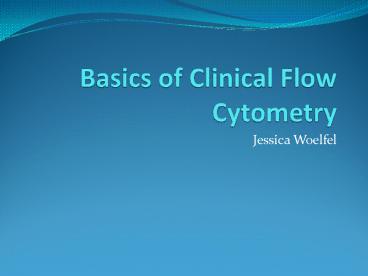Basics of Clinical Flow Cytometry - PowerPoint PPT Presentation
1 / 29
Title:
Basics of Clinical Flow Cytometry
Description:
Jessica Woelfel What is flow cytometry? The measurement of cells in a flow stream, which delivers the cells in single file past a point of measurement Basics of a ... – PowerPoint PPT presentation
Number of Views:790
Avg rating:3.0/5.0
Title: Basics of Clinical Flow Cytometry
1
Basics of Clinical Flow Cytometry
- Jessica Woelfel
2
What is flow cytometry?
- The measurement of cells in a flow stream, which
delivers the cells in single file past a point of
measurement
3
Basics of a flow cytometer
- Fluidics Cells in suspension move in single
file through a flow chamber - Optics Cells pass through a laser beam, scatter
light, and emit fluorescence - Electronics Light scatter and fluorescence are
converted to digital values and stored on a
computer
4
Forward scatter side scatter
- Forward scatter measures a cells size
- The larger the cell, the greater the forward
scatter - Side scatter measures a cells granularity
- The more granular a cell, the greater the side
scatter
5
Forward vs. side scatter plot
Can you figure out the different cell populations?
More granular cells ?
Larger cells ?
6
Forward vs. Side Scatter Plot
More granular cells ?
Larger cells ?
7
Fluorescence and Fluorochromes
- Antibodies are labeled with different
fluorochromes - The antibody will bind to an antigen on the
cells surface, if present - A fluorescent signal is generated if that
specific marker is present on the cells surface
8
Examples of Fluorochromes
9
2 Parameter Dot Plot
PerCP positive population (pink)
PerCP and PE positive population (yellow)
PerCP and PE negative population (green)
PE positive population (blue)
10
Some flow cytometry clinical applications
- Lymphocyte subset analysis (T cells, B cells, NK
cells) - Immune disorders
- Leukemia/lymphoma immunophenotyping
- Paroxysmal Nocturnal Hemoglobinuria
- Reticulocyte analysis
11
Lymphocyte subset analysis
- T cells
- Originate in bone marrow
- Mature in thymus
- Responsible for immunological defense mechanism
known as cell-mediated immunity - CD3 pan T-cell marker
- CD4 helper T-cell marker
- CD8 cytotoxic T-cell marker
12
Lymphocyte subset analysis
- B-cells
- Originate in the bone marrow
- Major role is to secrete immunoglobulins
- Responsible for humoral immunity defense
- CD19, CD20 - B-cell markers
13
Lymphocyte subset analysis
- Natural Killer cells
- Cytotoxic lymphocytes
- Cells kill by releasing small cytoplasmic
granules - CD16, CD56
14
Lymphocyte subset analysis
- T cells B cells NK cells 100 of
lymphocytes
15
Lymphocyte subset analysis
16
T cells B cells NK cells 100 of lymphs
69 15 13 97 (close enough)
17
Myeloid Lymphoid Differentiation
18
Leukemia/Lymphoma Immunophenotyping
Normal peripheral blood
CD45 vs. SS plot (common gating technique) CD45
common leukocyte antigen RBCs are negative for
CD45, therefore can be excluded from analysis.
19
Leukemia/Lymphoma Immunophenotyping
Normal bone marrow
Normal bone marrow shows immature and mature cells
20
Analysis and gating techniques
A population can be gated, then displayed on its
own in a separate plot.
Here, we are looking at the maturation pattern of
neutrophils.
21
Antibody combinations / panels
- Monoclonal antibodies (CD markers) are generally
grouped in lineage specific groups - Panels are lab-specific
- Example leukemia/lymphoma panels
- Shotgun approach uses a large number of
antibodies and covers everything. Diagnosis can
be made without having to go back and stain
additional tubes. This can be more expensive. - Screening approach uses a minimal set of
antibodies. More tubes will be stained with
additional antibodies if abnormalities are found.
This can be more time-consuming.
22
Example of a panel
Panel for LGL Leukemia
Tube FITC PE PerCP APC APC-Cy7
1 IgG1 IgG1 IgG1 IgG1 CD45
2 CD19 CD1656 CD3 CD14 CD45
3 CD57 CD16 CD3 CD56 CD45
4 CD57 CD56 CD4 CD8 CD45
5 CD7 CD2 CD3 CD5 CD45
6 CD94 CD4 CD3 CD8 CD45
7 TCRab TCRgd CD3 CD8 CD45
8 TCRab TCRgd CD4 CD8 CD45
9 CD27 CD28 CD3 CD8 CD45
10 CD57 CD5 CD3 CD8 CD45
23
Flow case example 1
Normal control
patient
24
Flow case example 1
Normal control
patient
25
Diagnosis flow case example 1
- Residual hairy cell leukemia variant, lambda
- Virtually all B-cells are monoclonal, positive
for CD19, CD20, CD22, CD103, spectrum of dim to
bright CD11c, and lambda surface light chain.
Negative for kappa surface light chain, CD25,
CD5, and CD10. Normal B-cells are lt1. This
immunophenotype is consistent with hairy cell
leukemia variant.
26
Flow case example 2
Normal control
patient
27
Flow case example 2
Normal control
patient
28
Diagnosis flow case example 2
- Patient has Paroxysmal Nocturnal Hemoglobinuria
(PNH). 20 of patients WBCs are
glycosylphosphatidylinositol (GPI) deficient and
4 of patients RBCs are GPI deficient.
29
Workflow in a flow cytometry lab
- Sample processing
- Acquiring sample on flow cytometer
- Data analysis
- Interpretation given by Hematopathologist
- Result entry into patients record

